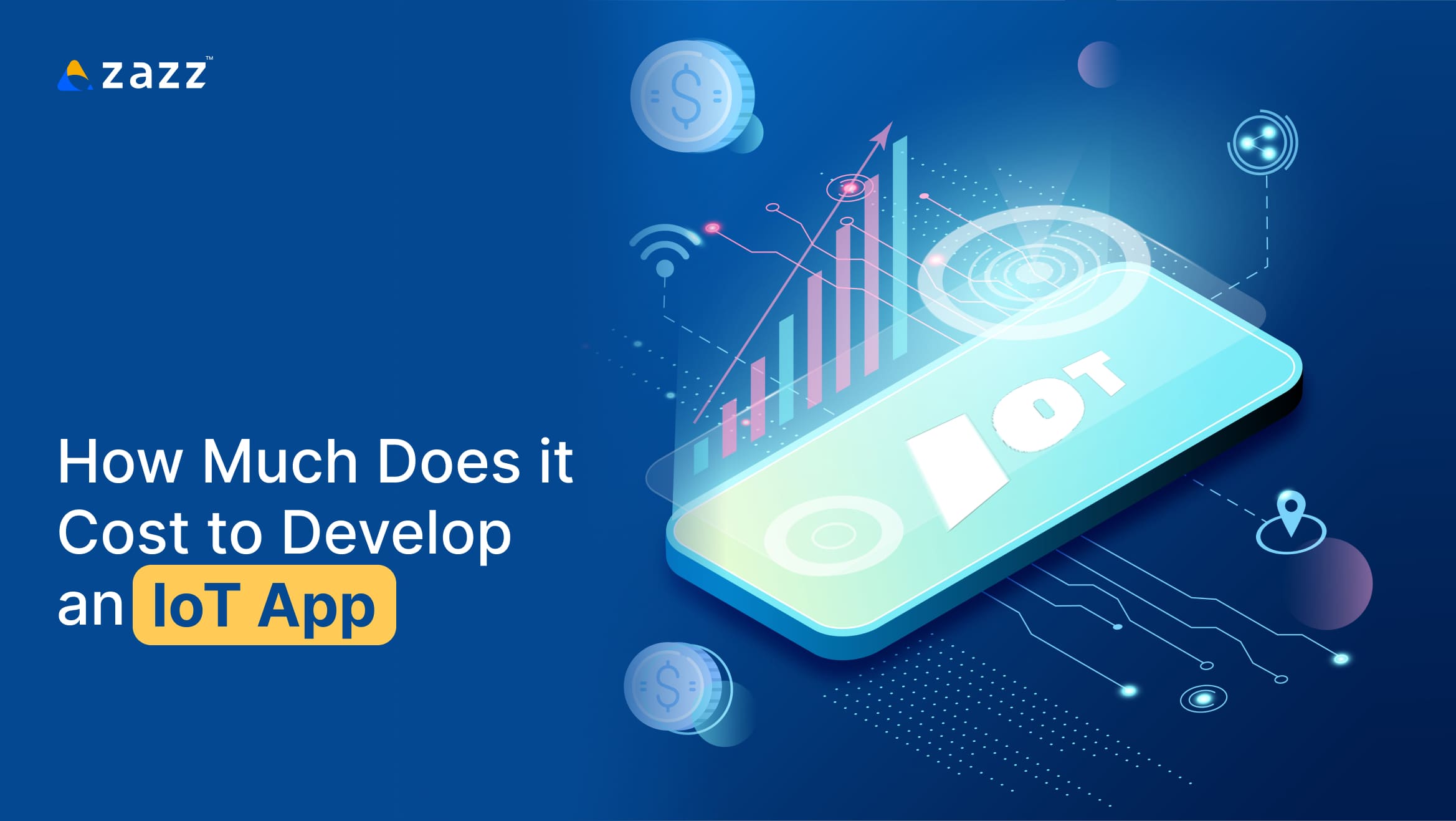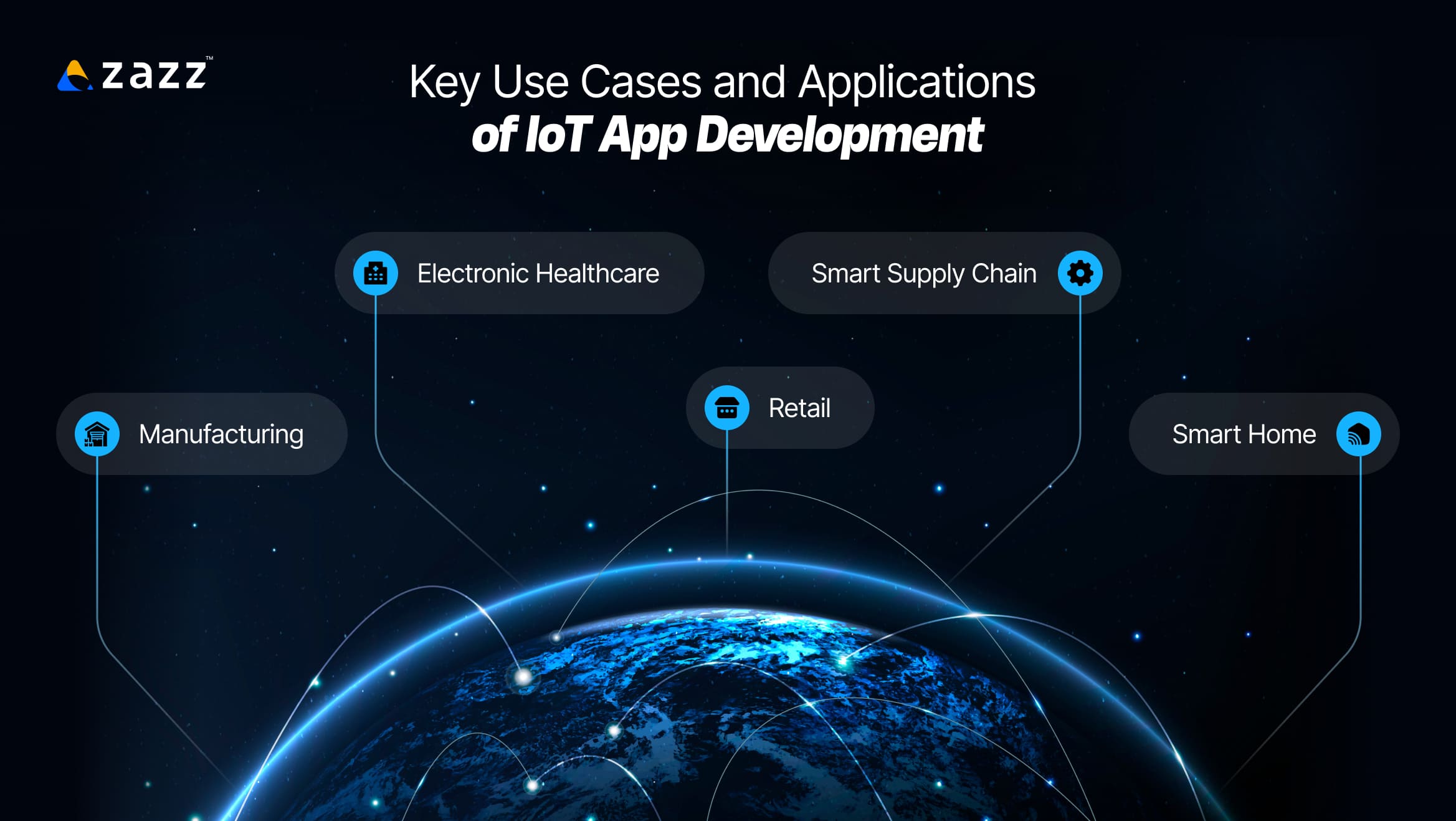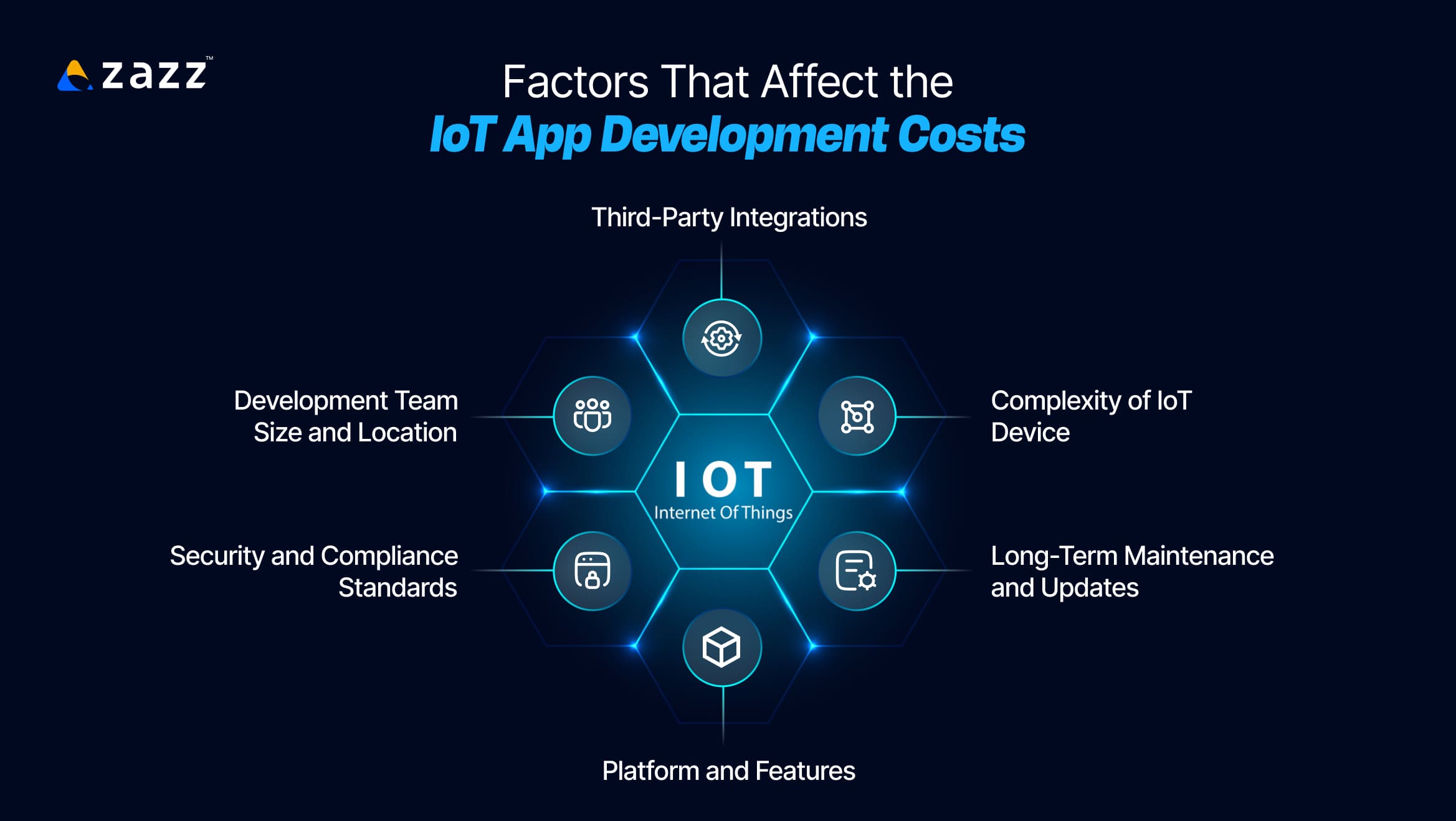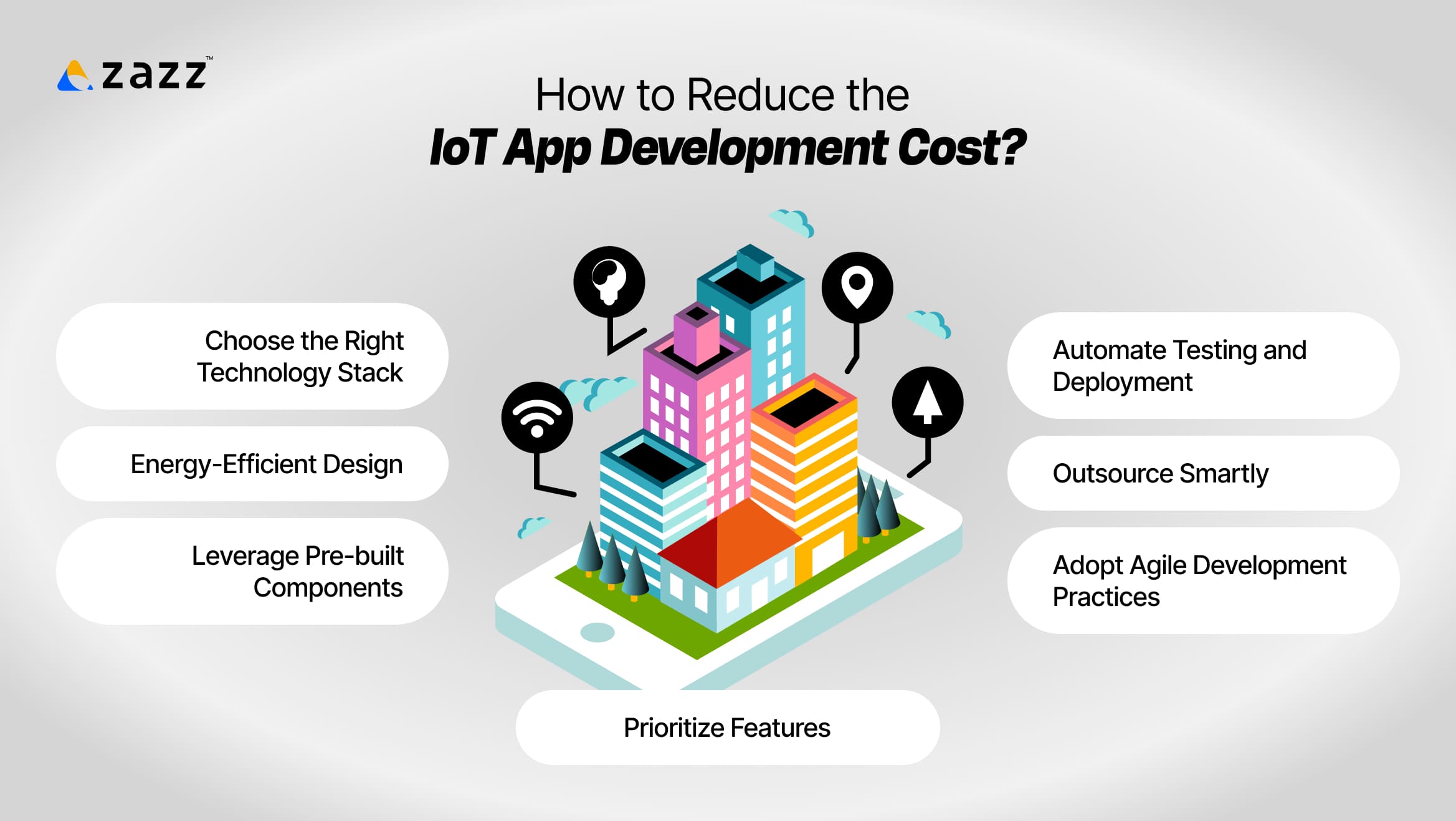
Creating a standout app is essential in the bustling IoT market. By 2030, we’re looking at an astounding 29.42 billion connected devices. So, what’s the investment like for IoT app development?
Well, you’re in the perfect spot to find out.
In this blog, we’ll break down the average cost to develop IoT products and explore the main factors that affect pricing.
Let’s get started!
What is an IoT app and how it works?
An IoT app is a type of application that connects and controls devices over the internet, allowing them to communicate with each other and with users. These apps are central to managing the network of interconnected devices known as the Internet of Things (IoT).
Here’s how it works: Each device in an IoT system is equipped with sensors or actuators that collect data or perform actions. This could be anything from a temperature sensor in a smart thermostat to a motion sensor in a security camera.
The IoT app gathers this data from the devices, processes it, and performs tasks based on this information. For example, if a temperature sensor detects that a room is too cold, the IoT app might automatically instruct a smart heater to turn on. This makes managing devices convenient and automated, often bolstering efficiency and user experience.
Related reading: IoT Application Development: A Complete Guide
Key Use Cases and Applications of IoT App Development

IoT app development is transforming various industries by optimizing efficiency, improving real-time decision-making, and creating new user experiences. Here are some key use cases and applications across different sectors:
Manufacturing
IoT apps in manufacturing help monitor equipment performance and predict maintenance needs. For example, sensors can detect abnormal vibrations or temperatures in machinery, and an IoT app can alert managers before a breakdown occurs. This preemptive approach reduces downtime and maintenance costs.
A real-life example is General Electric, which uses IoT to predict maintenance on their equipment and optimize factory operations.
Retail
In retail, IoT apps enhance the shopping experience and help manage inventory. Smart shelves equipped with weight sensors can track stock levels in real time and automatically reorder products when they run low.
Also, IoT-enabled beacons can send personalized promotions to customers’ smartphones as they navigate through store aisles. Sephora’s use of beacons to send personalized discounts and product recommendations to customers in-store is a notable example.
Smart Supply Chain
IoT apps streamline logistics and supply chain operations by providing real-time tracking of goods and vehicles. For instance, GPS and RFID tags help track products from the warehouse to delivery. This enables companies to optimize routes and reduce delays.
DHL uses IoT for real-time tracking of shipments, improving delivery times and reducing operational costs.
Electronic Healthcare
In healthcare, IoT apps are used for remote monitoring of patients’ health and managing medical equipment. Wearable devices can monitor heart rates, blood pressure, and other vital signs, sending data directly to healthcare providers.
This allows for timely interventions and reduces the need for in-person visits. Philips Healthcare offers wearable devices that monitor patients’ vitals and send alerts to doctors for any irregularities.
Smart Home
IoT apps in smart homes allow homeowners to control lighting, heating, security, and more from their smartphones. For example, a homeowner can see who is at the door through a smart security camera and unlock it remotely for guests.
Nest’s smart home products, such as thermostats and security cameras, can be controlled via an app. This is beneficial in enhancing home security and energy efficiency.
Related reading: IoT in Wearables: Benefits, Applications, and Latest Trends
How Much Does IoT App Development Cost?
Estimating the cost of developing an IoT app can vary widely because there are many factors that can affect the price.
Here’s an overview of potential IoT app development costs based on the complexity of the IoT app:
- Basic IoT apps: These apps usually handle simple tasks like controlling smart lights or a thermostat. The development cost for these apps can range from $30,000 to $50,000.
- Advanced IoT apps: Apps that connect to multiple devices and include features like real-time analytics or location tracking are more expensive. You might spend between $50,000 and $150,000 on these.
- Complex IoT apps: For large-scale solutions that involve lots of devices or use advanced technology like artificial intelligence, the costs start at $200,000 and can go much higher.
These costs are just for the app itself and don’t include the development of any physical IoT devices. Also, remember there will be ongoing costs for things like cloud hosting and data management.
Next, let’s look at what factors influence IoT development costs.
Factors That Affect the IoT App Development Costs

When considering the development of an IoT application, several key factors significantly influence the overall IoT development cost. Here’s a simplified overview of these factors:
Complexity of IoT Device:
- Simple IoT Device: The complexity of the IoT device plays a critical role in determining cost to develop IoT products. Simple devices like smart bulbs require straightforward app functionalities and are less expensive to develop.
- Complex IoT Device: On the other hand, apps for complex industrial IoT devices that manage heavy machinery or intricate systems require advanced features like real-time monitoring, predictive maintenance, and secure communication protocols, all of which significantly increase IoT development costs.
Development Team Size and Location:
- Team Size Impact: The size of the development team affects both the speed of development and the overall cost. A larger team can accelerate the development process but will increase labor costs. Conversely, a smaller team might reduce initial costs but could extend the development timeline, potentially leading to higher costs over a longer period.
- Geographical Influence: The location of your development team also significantly affects costs due to varying wage levels across different regions. For instance, developers in North America and Western Europe command higher hourly rates compared to those in Eastern Europe or Asia, impacting the overall budget.
Platform and Features:
- Platform Choice: The choice of platform(s) — whether Android, iOS, web, or cross-platform — affects development costs. Targeting multiple platforms increases complexity and costs, while opting for cross-platform development tools can potentially lower these costs by allowing developers to reuse code across platforms.
- Feature Complexity: The features and functionalities you choose to include in your app also play a crucial role in determining IoT development cost. Basic features may suffice for simple consumer apps, but more sophisticated enterprise-level apps require complex functionalities like automation, data analytics, and comprehensive user authentication systems, all of which require more development resources and increased costs.
Security and Compliance Standards:
- Security Requirements: IoT devices often handle sensitive data, making robust security measures essential. Implementing features such as end-to-end encryption, secure authentication, and data compliance standards not only is essential for protecting user data but also adds substantial IoT development costs due to the complexity of these implementations.
- Compliance with Regulations: Meeting compliance requirements for different regions (like GDPR in Europe) is essential for legal operation but requires additional effort in both development and ongoing compliance management, further increasing costs.
Long-Term Maintenance and Updates:
- Ongoing Maintenance: Maintaining an IoT app involves regular updates to fix bugs, enhance performance, and add new features. This continuous investment ensures the app remains functional and competitive but adds a significant ongoing cost.
- Scalability and Infrastructure: As the user base grows or as more devices connect, the infrastructure must scale accordingly. This includes upgrading servers, optimizing databases, and possibly expanding cloud services, which can be a considerable ongoing expense.
Third-Party Integrations:
Integrating third-party services can significantly enhance the functionality of an IoT app but also adds to the complexity and cost. Whether it’s cloud storage solutions, payment gateways, or data analytics services, each integration requires time for development and testing, API compatibility checks, and ongoing maintenance, all of which contribute to higher costs.
Related reading: 10 Best IoT Programming Languages
How to Reduce the IoT App Development Cost?

Reducing costs in IoT solution development can be strategic and involves several approaches to ensure that both the immediate and long-term expenses are managed effectively. Here are some additional pointers to consider:
Choose the Right Technology Stack
Selecting an appropriate technology stack is crucial to reduce overall IoT app development costs. Opting for open-source technologies can significantly reduce expenses since they eliminate licensing fees. Additionally, integrating your IoT solutions with the existing infrastructure prevents the additional costs associated with adopting new technologies. This approach not only minimizes spending but also streamlines development by leveraging familiar tools and systems.
Leverage Pre-built Components
Utilizing pre-built components from platforms like AWS IoT or Microsoft Azure IoT Hub can expedite development and decrease costs. These platforms offer ready-to-use modules and functionalities that can save time otherwise spent on developing similar components from scratch. Moreover, integrating existing APIs enhances functionality without the hefty price tag of custom development, ensuring a faster and more cost-effective solution deployment.
Prioritize Features
Developing a Minimum Viable Product (MVP) that focuses on core functionalities can significantly reduce initial costs. This approach allows for launching a product quicker and gathering user feedback, which is invaluable for prioritizing future feature development based on actual user needs and preferences. This strategic development not only ensures that investments are made in features that offer real value but also helps in managing the budget more effectively.
Adopt Agile Development Practices
Implementing Agile methodologies can greatly reduce IoT development costs by facilitating more flexible and efficient project management. Agile allows for continuous assessment and iteration throughout the development process, which helps in identifying potential issues early on. This early detection reduces the need for costly fixes at later stages and helps keep the project scope in check, preventing budget overruns due to feature creep.
Outsource Smartly
Outsourcing development tasks to regions with lower labor costs can provide significant savings without compromising on quality. Locations like Eastern Europe offer a skilled workforce at a fraction of the cost compared to Western countries. Flexible outsourcing arrangements also allow for scaling the team size according to project demands, which is more economical than maintaining a large permanent staff.
Automate Testing and Deployment
Automating testing and deployment processes through continuous integration and continuous deployment (CI/CD) pipelines can significantly reduce manual labor costs and minimize errors. Automation ensures consistent and speedy feedback, essential for maintaining quality and efficiency. This not only helps in keeping development costs down but also speeds up the market readiness of the product.
Energy-Efficient Design
Designing energy-efficient IoT devices and solutions can lead to long-term cost savings, making the product more attractive to eco-conscious consumers. Energy efficiency reduces the operational costs associated with power consumption and data handling, particularly important in large-scale deployments. This approach cuts IoT app development costs and improves the product’s marketability by appealing to sustainability-focused markets.
Related reading: 10 Best IoT Tools to Consider
Conclusion
Developing an IoT app involves understanding several cost factors, from the complexity of the devices and the development team’s location to the chosen platforms and necessary security measures. By considering these elements, businesses can better estimate the initial and ongoing IoT app development costs. For those looking to minimize these costs, strategies such as leveraging pre-built components, prioritizing core features, and adopting agile practices can be highly effective. Additionally, choosing the right technology stack and considering energy-efficient designs can further optimize expenses.
Zazz specializes in creating affordable, efficient, and scalable IoT solutions. With expertise in next-gen technology and a commitment to innovation, Zazz can help businesses develop IoT apps that are both cost-effective and high in quality. Whether you’re looking to build a basic app or a complex system, Zazz provides tailored solutions that meet your specific needs while keeping IoT software development costs manageable. Reach out to their expert team today!
Frequently Asked Questions
An IoT app is a software application that enables the control and management of connected devices within the Internet of Things ecosystem. These apps facilitate communication between devices and user interfaces to automate processes and improve efficiency.
The development time can vary greatly depending on the app’s complexity and the number of devices involved. Simple apps might take a few months, while more complex systems could require over a year of development.
Yes, Zazz offers comprehensive services that cover both the design and development of IoT apps. Our team ensures that the app is user-friendly and meets all functional requirements.
To reduce IoT app development costs, consider developing a Minimum Viable Product (MVP), using pre-built components, outsourcing to cost-effective regions, and focusing on core functionalities.
Zazz prioritizes security by implementing end-to-end encryption, secure authentication protocols, and compliance with relevant standards to protect user data and prevent unauthorized access.
Zazz provides ongoing support, maintenance, and updates to ensure the IoT apps continue to function optimally and adapt to evolving user needs and technological advancements.
Recent Articles
Table of Content 1. Skills and Workforce Evolution 2. Top...
Table of Content 1. Data Engineer vs. Data Scientist: Understanding...
Table of Content 1. What is the Carnival in Brazil?...












